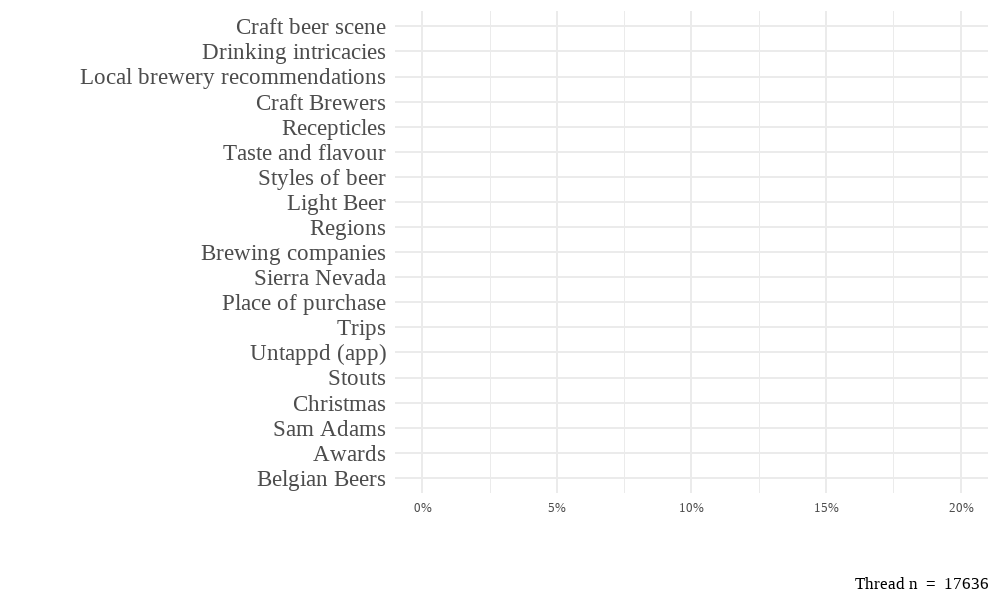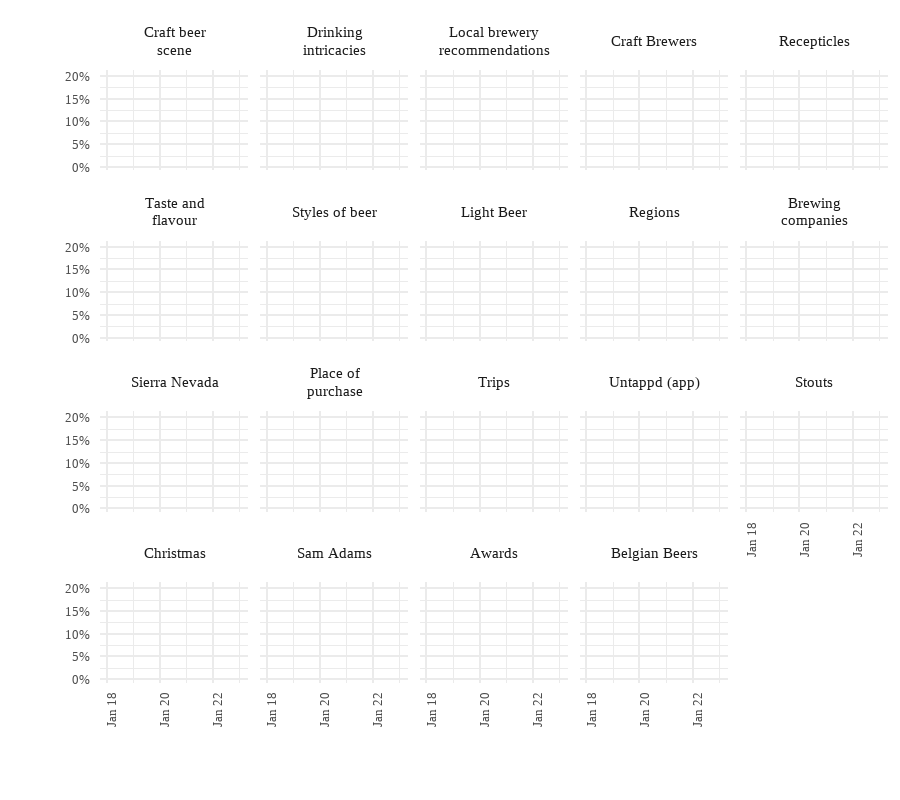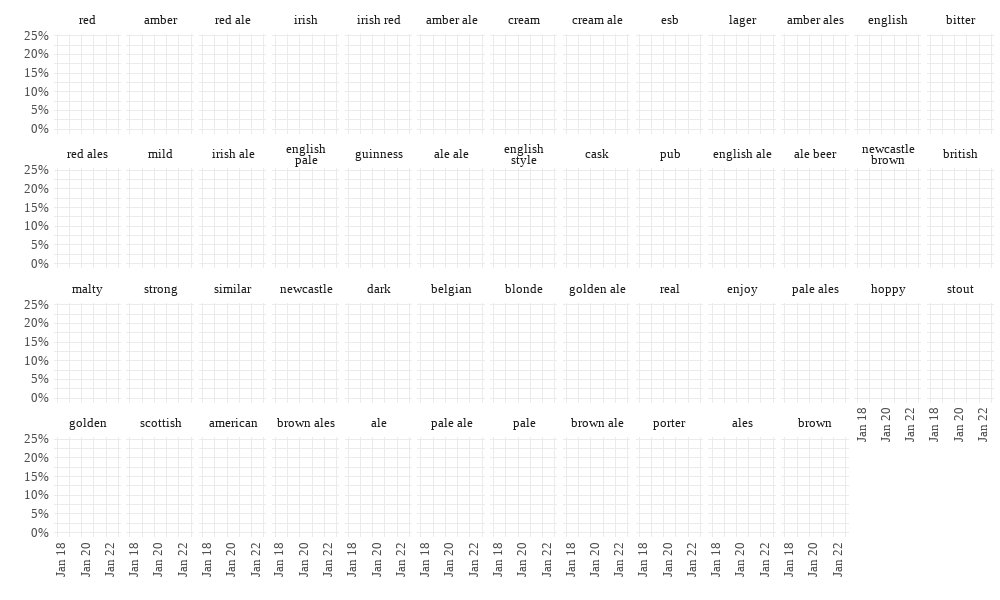Orientation within the beer market
The first step of the marketers playbook is orientation; i.e. what does the landscape look like? Typically, this is done with desk research, report reading, or the purchase of syndicated data sets.
Here at CT we do things a little differently. One of the methods we use for orientation is to analyse text pertaining to the area of interest. Our data sources are broad and curated, depending on the task.
For this demonstration, I want to have a look at the beer market. With our proprietary NLP methods, We analysed 5 years of online conversation about beer, from those that care enough about it to discuss it online.
Our model does the legwork to categorise conversations, which we then interpret and explore for intricacies.
These are the major themes of conversation starters and, thus, how people typically orient themselves within the category.
Next, we will probably want to look at how these things trend over time.
We can see that references to local brewery recommendations and ‘trips’ were affected by Covid, which makes sense, but both have mostly recovered.
This is all well and good, but we need to go deeper. How deep?
What we’ve modelled so far represents the questions that get posed, that kick starts the conversation.
We now run the same processes over the conversations themselves, within the question or starting point of the conversation. Someone might pose a question about styles of beer, but it can go in lots of different directions.
Because I’ve just said it… I’m going to focus on styles of beer.
Same process as before - What are the topics of the subsequent discussions when someone poses are question/point about styles of beer?
‘Craft beer industry’ are fairly non descript conversations that branch out to talk about the industry overall. It includes conversations about beers that win awards, guidelines, their perspective on what’s popular… Those sorts of things.
We are interested in the things that are specific. Which is basically everything underneath that theme.
So, as before… How are these themes trending?
Discussion around ‘ales’ is increasing. What’s going on there?
The first step we will generally take is to isolate the top 50 most important terms to a theme, and see how they’re trending. Identifying the top 50 most unique terms is done with a combination of frequency and uniqueness. I’ll spare you the boring statistical stuff behind it.
These are ordered by their ‘slope’, i.e. their overall rate of growth or decline. We also include their size on the scale, for obvious reasons. So, we can see that pale ales, brown ales, porters and stouts are important, but they’re either in decline of conversation or relatively flat.
The ale types in growth are reds (irish), amber ale, and cream ale.
We might also want to know what else gets mentioned when some of these components are mentioned.
We run various methods of correlative analysis within comments to understand that, when someone mentions ‘red’, what else are they likely to mention in their comment? From there, we also factor in proportion (volume of mentions) to create a normalised index of what else gets mentioned. A good way of viewing this information is in word clouds. Even though they’re not statistically brilliant, they give you a good steer on what’s going on.
So it’s not just red ale, it’s red beer. And they’re also likely to mention brown and/or amber ales, red stouts, and some brands. E.g. Killians.
What about amber?
OK, so amber and red are embroiled. Good to know.
I know nothing about this subject aside from that, among beer connoisseurs, amber and red ales appear to be the flavour of the month. Subsequently, I go and do a bit of Googling…
“As one might expect considering the name, amber and red ales are reddish coloured beers that are more malt-forward in their flavour profile than an average pale ale, with brewers of this style often using specialty malted grains in their malt bill.
In addition to influencing the colour, the use of specialty malts also adds to the flavour profile and body of the resulting beer, which manifests itself in a typically medium-bodied brew with moderately strong malt flavours of toast, caramel, and toffee alongside low to moderate hoppy fruit flavours of citrus, pine, resin, tropical fruit, or spice, depending upon the strain of hops used.”
Source: https://alkypal.com.au/beer/ale/amber-and-red-ale.html
So they’re currently big in to the malt flavour profiles. A slight shift away from fruity and citrus. If I wanted to get ahead in the craft beer space, I would probably take a deeper look in to that…
With this process, we am able to alert ourselves to a section of the category that might be worthy of investment. Given the industry focus and obsession with fruity beers at the moment, a shift towards sweet/heavier taste profiles could be an interesting play.
Now, of course, this is one small isolated component, and we are also looking at the ‘thought leaders’ of the category. I.e. people that care enough about beer to talk about it online.
It is not, nor should it be treated as gospel. But, when someone asks ‘what trends exist in the [X] category’, I hope you’ll agree that this is a much better approach than desk research or paying exorbitant amounts for syndicated data reports. Said reports also only really give you sales, they don’t tell you why nor do they alert you to unseen opportunities.
“Things that were, things that are, and some things that have not yet come to pass”.
Thanks for reading!









